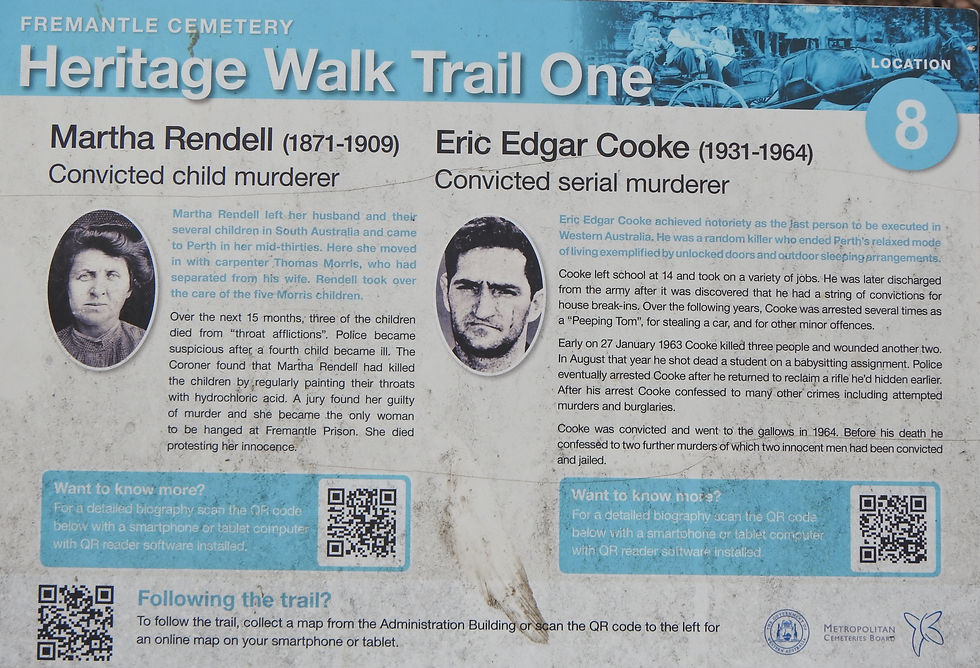A free self guided tour of a cemetery is a great way to learn some of the local characters from the past, both famous and infamous. Fremantle Cemetery Heritage Walk certainly fulfilled this requirement.
Put on a pair of comfy walking shoes and enjoy the walk. It took me about an hour to do to whole 35 sites. They are concentrated in a small area of the large cemetery. Over 60,000 cremations and 40,000 burials are here.
If you have less time, it is always possible to come back and do more at any time. It was extremely interesting and each numbered plaque gives a brief insight into the persons life, ensuring that they have not been forgotten, and commemorating their contributions. The cemetery information centre is open between 8.30am - 5.00pm Monday to Friday, and 8.30am - 12.30pm Saturdays. There you can get a leaflet that has a map marking the numbered sites on one side and the names of the deceased on the back.
The most visited grave site and the start of the tour is that of Ronald Belford "Bon" Scott (1946 - 1980), Rock musician and best known as the singer in AC/DC. Bon died in London and was cremated. His ashes were thrown onto the wind. This is a memorial plaque to him, not the actual burial place of his ashes.

It is local tradition here to open a can and pour the contents onto the ground. His family have donated a lovely seat nearby for people to sit and contemplate.


Merchants, manufacturers, nurses, criminals, seaman are among those remembered here.
The second oldest grave is that of infant Jane Frances Scott (1831-1833).


Her headstone now rests near her parents. Her father Daniel Scott (1800 - 1865) was a master mariner, and he is also on the heritage walk.


Charles Yelverton O'Connor (1843 - 1902) was an engineer who constructed the Fremantle Harbour (thought impossible at the time) and the 550 km (330 mile) Goldfields Pipeline that brought fresh water from Perth to the gold rush town of Kalgoorlie. The press of the day were not kind to CY O'Connor and he shot himself while riding his horse in the ocean. At CY O'Connor beach near Fremantle, there is a statue in the ocean of Charles on his horse.


Convicts are prisoners from the early days of Australia are entertaining now that time has detached the stigma from them. Several murderers are buried here without headstones. However, the infamous Moondyne Joe (Joseph Bolitho Johns (1827-1900) has a headstone and is described as an Escapologist rather than a convict thief and bushranger.


The child murdered Martha Rendell (1871 - 1909), serial murdered Eric Edgar Cooke (1931 - 1964), murderer Brian William Robinson (1939-1964) and murderer Karol Tapci (1930-1952) are in unmarked graves.



Shipping has been vital in the continuing growth and prosperity of Western Australia. The Shipwreck Memorial is dedicated to those who died from the two tall ships shipwrecked on 11-12 July 1899 off Rottnest Island, in a heavy force 10 storm. The "Carlisle Castle" lost all 22 hands onboard. The "City of York" lost 11 of the 26 people onboard.


The Pensabene grave site is the end of the walk, with Saverio Pensabene, a fisherman, (1914 - 1989) remembered here.


Whaler and general seaman William Adams (1792 - 1867) and his spouse, the first midwife in Fremantle, Elizabeth Adams (1808 - 1891) are remembered.


In the 1830s the average family consisted of 6 to 8 children, with many families having more than this. Women generally had one birth every two years during their child bearing ages. With only laudanum for pain relief and high risks of complications, a midwife to assist with births was a very important member of the community. Husbands usually did not attend, and older children sent away to family or friends during the birth. Elizabeth Adams above and Annie Jane Clune (1870 - 1945) were much admired women in early Western Australia. Annie was known as Nurse Sheedy, from her first marriage to James Sheedy who died in 1908.


These are just a few of the 34 remembrances on the Heritage Walk trails. After the walk, I researched the people and learnt a lot about the early days in Fremantle history. My biggest take away is my admiration of the pioneers who persevered in tough times, to make this part of Perth blossom and succeed. I would highly recommend the walk to everyone. There are seats scattered around to have a rest. (It is a good visit to a cemetery, as long as you are not the one lying down).
My next cemetery visit will be to the Perth cemetery at Karrakatta. Look for that separate post.
Happy Travels!






Comments